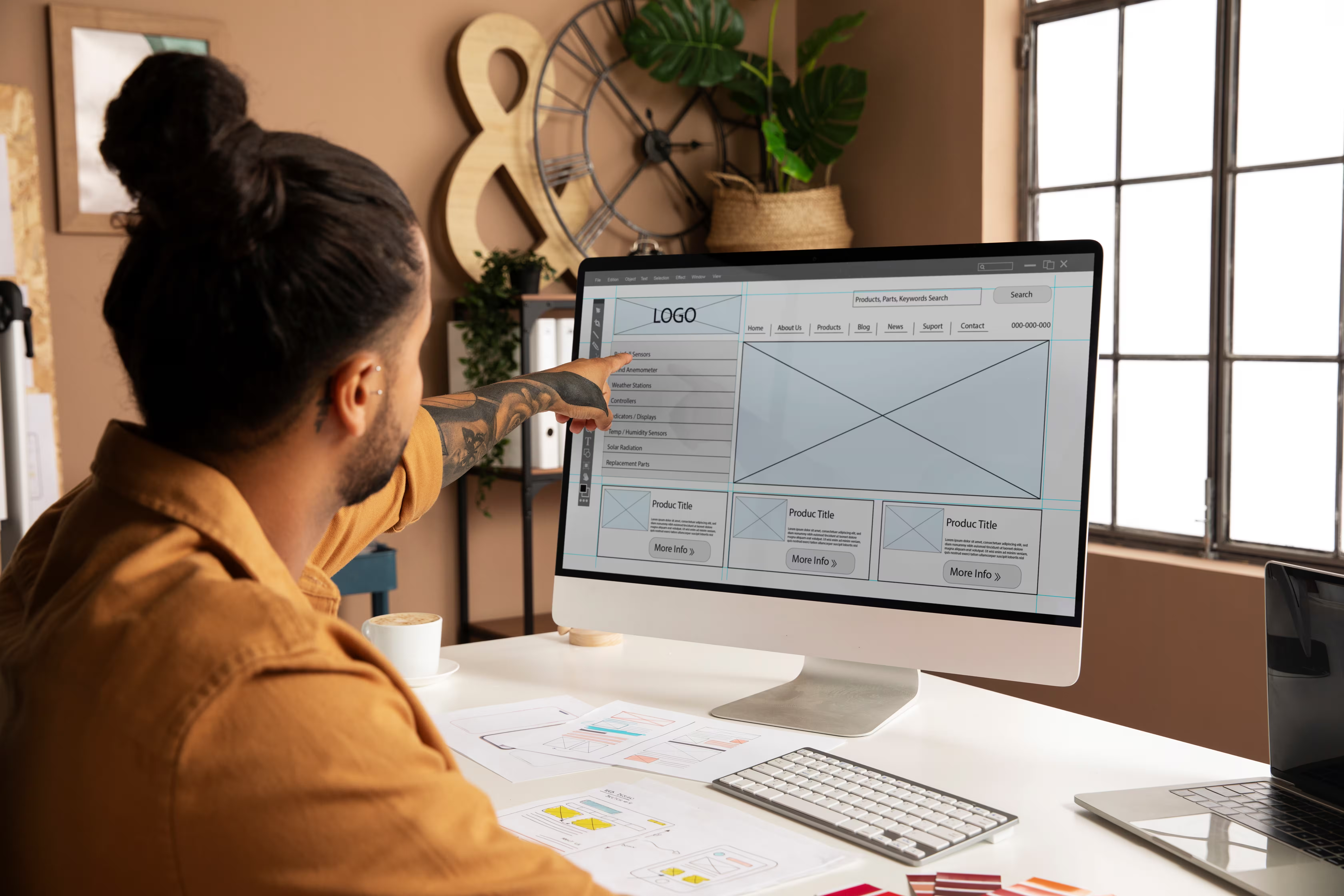Webflow is known for its no-code ease and strong CMS capabilities, making it a go-to for designers looking to build complex sites without the backend hassle. It’s like a designer’s toolbox. It’s sleek, versatile, and packed with all the right tools to bring your vision to life. On the other hand, Framer is the newcomer shaking things up with a focus on cutting-edge interactions, smooth animations, and a more creative, flexible approach to design. Framer is like a high-end art studio. It’s focused on precision and motion, giving designers the freedom to experiment with animations and interactions, but sometimes leaving the fundamentals behind. So, who comes out on top?


Webflow vs Framer: What sets these two platforms apart?
Webflow and Framer stand out for their unique strengths. Both offer powerful tools, but each has its own focus and target audience.
The real challenge comes when choosing between a no-code platform that can deliver a complete, production-ready website and a design-driven tool that excels at visual storytelling and interactive experiences.
Let’s break down what sets these two platforms apart and how each caters to different needs.
Webflow
A visual development platform that brings together no-code development, design, CMS, SEO, hosting, and analytics. This makes it ideal for businesses and agencies that want to create production-ready websites without relying on developers.
It’s built to scale and manage content easily, all while offering robust customization options. You get to create a functional site from start to finish, all within one collaborative platform.
Ideal for: Webflow appeals primarily to businesses and agencies looking for a comprehensive website-building platform that combines design flexibility with powerful CMS and hosting.
Framer
Originally a prototyping tool, Framer has evolved into a website builder with a particular focus on animations and interactions. It’s created for designers who want to push the boundaries of motion and visuals.
Framer is all about creating stunning visual experiences through interactive elements, which is perfect for those who care about making every page feel dynamic and alive.
Ideal for: Framer is more suited for designers who want to focus on engaging interactions and crafting visually captivating sites, often with a strong emphasis on motion design.
Webflow vs Framer speed: Performance at scale
When it comes to scaling your website and ensuring fast load times, Webflow vs Framer speed matters. Both platforms have their perks, but their performance at scale is a key differentiator.
Here’s how they stack up:
Webflow
Webflow is engineered for speed and enterprise-level scalability, making it a reliable choice for fast-growing SaaS brands and content-heavy businesses. With an infrastructure powered by AWS hosting and a global Fastly CDN, it helps pages load quickly regardless of user location.
Beyond hosting, Webflow builds performance into the way sites are created and delivered:
- Enterprise-grade uptime and security: backed by AWS, with automatic backups and SSL certificates included.
- Fastly CDN edge network: content is cached and served from the nearest global node, minimizing latency for international audiences.
- Automatic image optimization: Webflow generates responsive image variants, compresses them, and supports next-gen formats like WebP to keep pages lightweight.
- Minified and clean code output: by default, Webflow publishes semantic, compressed HTML/CSS/JS for faster rendering and SEO benefits.
- Built-in caching layers: static assets are cached intelligently, reducing repeated load times.
- Scales without extra configuration: whether it’s 100 or 1,000+ pages, Webflow handles the growth without slowing performance.
- Real-world proof: brands like Jasper and VRIFY use Webflow to manage sites with high traffic and global reach while maintaining consistently fast load times.
In short, Webflow actively optimizes delivery, so scaling up traffic or content won’t compromise performance.
Framer
Framer shines with its design-first approach and smooth interactions, making it ideal for portfolios, landing pages, and creative campaigns. Its JavaScript-driven animations create engaging, visually rich experiences that stand out.
But when projects scale, those same interactions can become a bottleneck.
Larger sites with many pages or heavy animations often face slower load times and reduced performance. While Framer’s Vercel hosting ensures solid baseline speed, it lacks the enterprise-grade infrastructure and CMS scalability that Webflow offers.
Key aspects of Framer’s performance:
- Framer Interactions: deliver rich animations and immersive transitions, making it ideal for portfolios, landing pages, or creative campaigns.
- Optimized for smaller sites: performs well when page count is limited and animations are kept focused.
- JavaScript-heavy rendering: while visually impressive, this can slow down load times and reduce Lighthouse performance scores at scale.
- Hosting via Vercel: provides strong baseline speed and reliable infrastructure, but less enterprise-grade optimization compared to Webflow’s AWS + Fastly setup.
- Limited content management for scaling: larger sites with 100+ pages may require manual structuring and workarounds, since Framer is not as CMS-driven as Webflow.
- Best-fit use cases: startups looking for a stunning product showcase, design studios highlighting their work, or creative campaigns with a few high-impact pages.
To summarize, Framer excels at delivering jaw-dropping visuals and interactivity. But for businesses scaling into large, content-heavy, or high-traffic websites, performance trade-offs start to show.
The verdict
If Webflow vs Framer speed is your deciding factor, Webflow takes the crown for larger, scalable websites. Its performance is built for speed and scalability, especially when managing complex sites.
On the other hand, Framer is great for design-heavy sites with fewer pages, but its reliance on animations can compromise speed as the site grows.
For example:
How Flowout helped Seabrook relaunch their website in Webflow for improved performance
Seabrook Technology, a global provider of end-to-end manufacturing solutions for the medical device industry, needed a complete overhaul of its website.
Their WordPress-based site was difficult to maintain, visually outdated, and unable to keep up with their growing content and engagement needs. Performance gaps limited user experience, and the team required a more scalable, modern solution to support growth.
Flowout led an end-to-end web revamp procedure, ensuring to improve site performance and usability.
Key steps included:
- Used Webflow’s optimized CMS to boost page load speed.
- Created a modern, fast design for better mobile performance.
- Integrated Livestorm for smooth webinar hosting without slowing down the site.
- Optimized site elements for faster loading and fewer delays.
The results:
Seabrook’s new Webflow site launched with a sleek, high-performing front end that was noticeably faster and easier to manage than their old WordPress setup.
The improved performance provided a stronger foundation for user engagement, content delivery, and future growth, while modern visuals reinforced their updated brand identity.
Framer interactions: When visual motion takes the lead

Framer is perfect for creating stunning micro-interactions and motion designs.
So let’s explore what Framer brings to the table.
Framer allows designers to prototype highly interactive experiences with ease.
Want to make a button bounce, a scroll effect sparkle, or an image slide in from the side? Framer lets you do it all without touching a single line of code.
The drag-and-drop functionality and intuitive controls make it a playground for designers who live and breathe visual motion.
Features that shine:
- Interactive prototypes: You can quickly create dynamic prototypes that feel like real, interactive websites.
- Micro-interactions: Framer lets you create small but meaningful animations for elements like buttons, menus, and forms to delight users and guide them through the experience.
- Real-time previews: You can see your animations and interactions come to life instantly without waiting for previews or page refreshes.
But, here’s the catch.
When it comes to long-term scalability, those cool Framer interactions can sometimes complicate things.
For enterprise-level websites or SaaS products, too many moving parts can lead to maintenance headaches. This can become an issue when the site grows, and updates or bug fixes are needed.
Some of Flowout’s designers point out that Framer is fantastic for initial prototypes and short-term projects. But when it’s time to scale, it circles back to the dilemma once again, that is, Webflow vs Framer for designers.
Webflow’s infrastructure just makes it easier to manage complex projects without the performance or maintenance concerns.
So, for those looking for a platform that can keep up with long-term growth, Webflow often emerges as the better option.
Webflow vs Framer for designers: Control and collaboration
Design thrives on control and collaboration, but which platform truly delivers both for designers: Webflow or Framer?
Let’s dive in and find out. Webflow has built a reputation for giving designers pixel-perfect control while keeping development in mind. Framer, on the other hand, places a strong emphasis on interactive, visually rich designs.
Webflow: Seamless collaboration in action
With Webflow, everyone knows their part, and they play together in perfect harmony.
With Reusable Components and CMS Collections, Webflow enables designers to create scalable, consistent content structures. Flexbox and CSS Grid make layout control precise, while Interactions bring dynamic elements to life.
This means you don’t have to reinvent the wheel with every new page or feature.
Plus, Webflow’s collaboration features allow designers, developers, and marketers to work seamlessly within the same environment. With easy handoffs and workflows, you can keep the whole team in sync.
- Reusable components: Create design systems that scale easily across your entire website.
- Scalable CMS: The CMS lets you structure content in a way that’s flexible and efficient.
- Seamless collaboration: Designers, developers, and marketing teams can all contribute across different modes, without stepping on each other’s toes.
Framer: Visuals over structure
Framer shines when it comes to creativity. It’s a dream tool for designers who want to prototype quickly, test bold ideas, and play with animations without getting bogged down by setup. The platform makes it easy to bring visual concepts to life fast, which is why many solo creators love it.
Where Framer struggles is in scaling those projects beyond the design stage.
Unlike Webflow, it doesn’t have a structured CMS or advanced content workflows, which makes scaling content-heavy sites or coordinating with marketing and dev teams more complex.
For smaller, design-led sites, this works fine. But for bigger, multi-team projects, those gaps can slow you down.
- Solo designer’s dream: Great for fast prototyping, experimenting with animations, and validating design concepts without heavy setup.
- Real-time collaboration: Multiple designers can co-create in the same space, making early-stage design teamwork fluid and fun.
- Limited CMS for scale: With only 10 CMS collections allowed, managing large or complex sites is tougher compared to Webflow’s 10,000-item capacity.
- Workflow gaps: While collaboration works for design, handing projects off to developers or marketers is less seamless, especially as websites grow.
The verdict
For solo designers, Framer's quick and easy setup is hard to beat. But let's not forget that a project is successful only when all teams are equipped with control, scalability, and smooth collaboration.
Webflow is built for long-term, collaborative projects, making it the clear winner for teams looking to scale and work together.
Webflow or Framer: Which tool should you choose?
Here's a quick comparison table to help you make the best call for your next project.
Choose Framer if:
- You're creating interactive prototypes or designs.
- Animation and complex interactions are a must for your design.
- You don't need an advanced CMS or scalability.
Choose Webflow if:
- You're building something more robust: a SaaS site, an enterprise platform, or a marketing engine.
- You need scalability and long-term flexibility.
- You want to streamline collaboration across teams without losing design integrity.
- You want access to an extensive repository of templates and resources, since Webflow offers an easy learning curve and frequently updated features.
While both platforms have their place, Webflow remains the enterprise-ready option with more muscle for scaling and complex projects.
Conclusion: Why Webflow is the enterprise-ready choice for scalable web design
Hope we’ve helped resolve your Framer vs Webflow dilemma. When it comes to scalable, enterprise-ready web design, it’s not just about choosing between two platforms; it’s about picking the right tool for your growth.
While Framer shines in quick prototyping and visuals, Webflow takes the lead for enterprises with its robust CMS, seamless collaboration, and speed. Its ability to scale and adapt is unmatched, making it the clear winner for businesses aiming for sustained growth.
Framer is making waves with its fresh, dynamic approach to web design, and there’s no doubt its future looks exciting. But if you’re after a platform that’s already battle-tested and trusted for design-to-dev handoff, Webflow still wears the crown.
Frequently asked questions
Is Framer faster than Webflow for building small sites?
Framer can be pretty quick for building small sites, especially for prototypes or portfolio pages with heavy animations. However, when it comes to Webflow vs Framer speed, Webflow offers more optimization options for performance, which ensures better scalability even for smaller sites as they grow.
Does Webflow support the same level of interactions as Framer?
While Framer is known for its intricate animations and micro-interactions, Webflow also supports advanced animations and interactions through its native tools. Webflow’s animations are more optimized for production websites, ensuring better performance across larger-scale projects.
Which platform is better for enterprise-level projects?
For enterprise-level projects, Webflow is the clear winner. Its scalable CMS, advanced design features, and seamless collaboration tools make it ideal for large teams and growing businesses, whereas Framer lacks the necessary tools for long-term scalability and complex CMS needs.




















